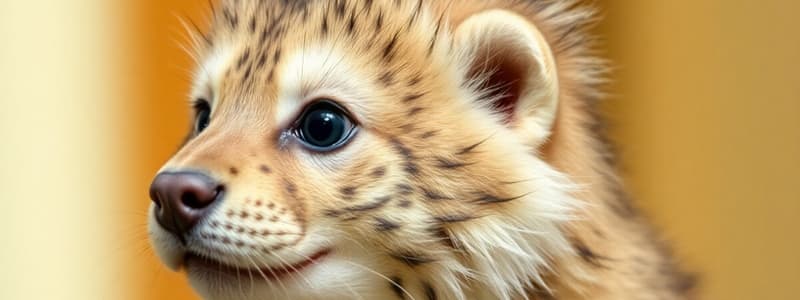Podcast
Questions and Answers
Which neurotransmitter is primarily involved in muscle movement and memory?
Which neurotransmitter is primarily involved in muscle movement and memory?
- Dopamine
- Serotonin
- Acetylcholine (correct)
- Norepinephrine
What does the axon of a neuron do?
What does the axon of a neuron do?
- Receives signals from other neurons
- Insulates the neuron
- Stores neurotransmitters
- Sends electrical impulses away from the cell body (correct)
Which research method is most suitable for establishing cause-and-effect relationships?
Which research method is most suitable for establishing cause-and-effect relationships?
- Correlational Research
- Descriptive Research
- Experimental Research (correct)
- Qualitative Research
What is the primary focus of the psychoanalytic approach in psychology?
What is the primary focus of the psychoanalytic approach in psychology?
Which conditioning method involves associating a neutral stimulus with an unconditioned stimulus to elicit a conditioned response?
Which conditioning method involves associating a neutral stimulus with an unconditioned stimulus to elicit a conditioned response?
Which approach in psychology emphasizes personal growth and self-actualization?
Which approach in psychology emphasizes personal growth and self-actualization?
In the context of physiological processes, what part of a neuron is responsible for receiving signals?
In the context of physiological processes, what part of a neuron is responsible for receiving signals?
What is the main characteristic of correlational research?
What is the main characteristic of correlational research?
What characterizes REM sleep?
What characterizes REM sleep?
What defines classical conditioning?
What defines classical conditioning?
Which type of reinforcement involves the addition of a pleasant stimulus to increase behavior?
Which type of reinforcement involves the addition of a pleasant stimulus to increase behavior?
What is the main distinction between retrograde and anterograde amnesia?
What is the main distinction between retrograde and anterograde amnesia?
Which of the following is an example of taste aversion?
Which of the following is an example of taste aversion?
Which schedule of reinforcement provides reinforcement after a random number of responses?
Which schedule of reinforcement provides reinforcement after a random number of responses?
What is an example of deep encoding in memory?
What is an example of deep encoding in memory?
What phenomenon describes memories that are distorted or fabricated?
What phenomenon describes memories that are distorted or fabricated?
What does serotonin primarily affect?
What does serotonin primarily affect?
Which lobe of the brain is responsible for vision?
Which lobe of the brain is responsible for vision?
What is the role of the sympathetic nervous system?
What is the role of the sympathetic nervous system?
According to the Schachter-Singer Theory, emotion is determined by what?
According to the Schachter-Singer Theory, emotion is determined by what?
Which neurotransmitter is primarily inhibitory and calms the brain?
Which neurotransmitter is primarily inhibitory and calms the brain?
What is the primary focus of the frontal lobe?
What is the primary focus of the frontal lobe?
Which stage of sleep is crucial for physical recovery?
Which stage of sleep is crucial for physical recovery?
The Cannon-Bard Theory posits that emotions and physiological reactions occur how?
The Cannon-Bard Theory posits that emotions and physiological reactions occur how?
Study Notes
Classical vs. Operant Conditioning
- Classical conditioning is learning by association, like Pavlov's dogs associating the bell with food and salivating.
- Operant conditioning involves learning through consequences, either reinforcement (positive or negative) or punishment, developed by B.F. Skinner.
Reinforcement and Punishment
- Positive Reinforcement: Adding a pleasant stimulus to increase behavior.
- Negative Reinforcement: Removing an unpleasant stimulus to increase behavior.
- Positive Punishment: Adding an unpleasant stimulus to decrease behavior.
- Negative Punishment: Removing a pleasant stimulus to decrease behavior.
Schedules of Reinforcement
- Fixed-Ratio: Reinforcement after a set number of responses.
- Variable-Ratio: Reinforcement after a random number of responses.
- Fixed-Interval: Reinforcement after a fixed time period.
- Variable-Interval: Reinforcement after a variable amount of time.
Taste Aversion
- A form of classical conditioning where an organism learns to avoid food that caused illness.
Memory Types
- Episodic Memory: Memory of personal experiences.
- Semantic Memory: General world knowledge (facts).
- Implicit Memory: Unconscious memory, like procedural memory for tasks learned through repetition.
Amnesia
- Retrograde Amnesia: Loss of past memories.
- Anterograde Amnesia: Inability to form new memories.
Encoding and Levels of Encoding
- Shallow Encoding: Based on physical traits like how a word looks or sounds.
- Deep Encoding: Involves semantic processing, understanding the meaning of the information.
Memory Failures and False Memory
- Forgetting: Can occur due to decay, interference, or retrieval failure.
- False Memory: Memory that is distorted or fabricated. Studies by Elizabeth Loftus showed how suggestive questioning can lead to false memories.
Psychology Approaches
- Biological Approach: Focuses on genetics, brain structures, and neurotransmitters, viewing behavior from biological processes.
- Behavioral Approach: Studies observable behavior, emphasizing learning through conditioning (e.g., Pavlov's dogs for classical conditioning).
- Cognitive Approach: Examines internal mental processes such as memory, problem-solving, and perception.
- Psychoanalytic Approach: Developed by Freud, focusing on unconscious processes and unresolved childhood conflicts.
- Humanistic Approach: Emphasizes personal growth, self-actualization, and free will (e.g., Maslow's hierarchy of needs).
- Sociocultural Approach: Considers how social and cultural environments influence behavior.
- Evolutionary Psychology: Examines behavioral traits as adaptations shaped by natural selection.
Research Approaches
- Descriptive Research: Involves observing and describing behavior without manipulating variables (e.g., case studies, naturalistic observation, surveys).
- Correlational Research: Studies relationships between variables to determine if they are associated, but without establishing causation.
- Experimental Research: Manipulates one variable (independent) to observe its effect on another (dependent), establishing cause and effect.
- Qualitative Research: Explores complex behaviors through interviews, focus groups, and content analysis, focusing on understanding rather than quantifying.
- Longitudinal Research: Research that follows subjects over time.
- Cross-Sectional Studies: Compare different groups at one point in time.
Parts and Functioning of the Neuron
- Soma (Cell Body): Contains the nucleus and keeps the neuron functioning.
- Dendrites: Receive signals from other neurons.
- Axon: Sends electrical impulses (action potentials) away from the cell body.
- Myelin Sheath: Insulates the axon to speed up signal transmission.
- Synapse: The gap between neurons where neurotransmitters are released to communicate with other neurons.
Neurotransmitters
- Acetylcholine: Involved in muscle movement and memory.
- Dopamine: Influences reward, motivation, and motor control.
- Serotonin: Affects mood, sleep, and appetite.
- GABA: Inhibitory neurotransmitter that calms the brain.
- Norepinephrine: Linked to arousal and alertness.
- Glutamate: Excitatory neurotransmitter involved in learning and memory.
Lobes of the Brain
- Frontal Lobe: Involved in reasoning, planning, movement, and problem-solving. Location: front of the brain, behind the forehead.
- Parietal Lobe: Processes sensory information like touch and spatial awareness. Location: Top and towards the back of the brain, near the crown of the head.
- Temporal Lobe: Associated with auditory processing and memory. Location: sides of the brain, near the ears.
- Occipital Lobe: Responsible for vision. Location: back of the brain, near the base of the skull.
Divisions of the Nervous System
- Central Nervous System (CNS): Comprises the brain and spinal cord.
- Peripheral Nervous System (PNS): Divided into two sections, somatic and autonomic nervous systems.
- Somatic Nervous System: Controls voluntary movements.
- Autonomic Nervous System (ANS): Regulates involuntary functions and is subdivided into:
- Sympathetic Nervous System: Prepares the body for fight or flight.
- Parasympathetic Nervous System: Restores the body to a state of calm.
Theories of Emotion
- James-Lange Theory: Emotions result from physiological responses (e.g., we feel fear because we tremble).
- Cannon-Bard Theory: Emotions and physiological reactions occur simultaneously.
- Schachter-Singer Theory: Emotion is determined by physiological arousal and cognitive labeling of that arousal.
- Dobson-Yorke Theory: Even simple systems that follow clear rules can behave unpredictably, where small changes at the start can lead to big differences in the outcome.
Stages of Sleep
- Stage 1 (NREM): Light sleep, transition between wakefulness and sleep.
- Stage 2 (NREM): Heart rate slows, body temperature drops.
- Stage 3 (NREM): Deep sleep, crucial for physical recovery.
- Stage 4 (REM): Dreaming occurs, brain activity is high, but the body is immobilized.
Studying That Suits You
Use AI to generate personalized quizzes and flashcards to suit your learning preferences.
Related Documents
Description
Explore the key concepts of classical and operant conditioning in this quiz. Learn about the principles of reinforcement and punishment, as well as different schedules of reinforcement. Test your knowledge on taste aversion and its implications in learning.




